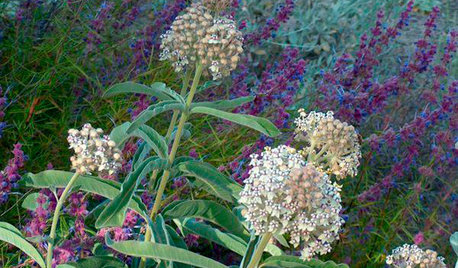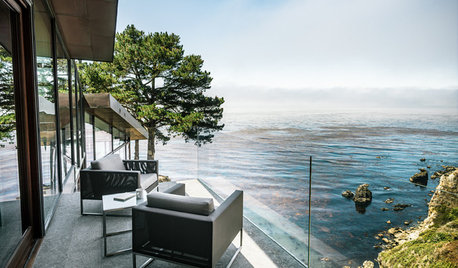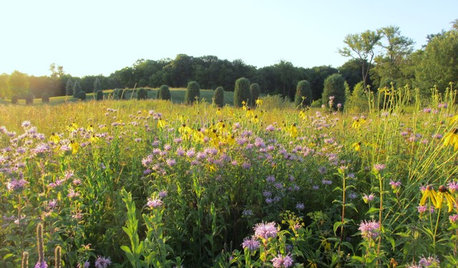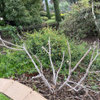I live atop a coastal bluff 1/1 slope in san pedro. there has been little or no erosion but the adobe soil is mixed with small fragmented rock and there has been slippage and erosion on other properties in the area.
the slope descends 120 feet with the upper half being mixed ice plant and the lower half mostly weeds and some small shrubs.
questions:
1. in planting the shubs and trees to hold the soil, should I remove the iceplant first, or just plant the trees and shrubs amongst the iceplant?
2. any additional suggestions to the advice from gardenguru joe who previously wrote the following:
Posted by gardenguru1950 SunsetZ15 (My Page) on Fri, May 13, 05 at 21:26
1. Plan construction/planting activities during summer and fall, so that erosion control measures can be in place when the rain comes.
2. Preserve existing vegetation as much as possible.
3. Limit grading and plant removal to the areas under current construction.
4. Preserve the natural contours of the land and disturb the earth as little as possible. This latter part is very important.
5. Limit the time in which graded areas are exposed.
6. Minimize the length and steepness of slopes by benching, terracing, or constructing diversion structures.
7. Landscape areas that you do bench to stabilize the slope and improve its appearance.
8. As soon as possible after grading a site, plant vegetation on all areas that are not to be paved or otherwise covered.
Select from the following plants, choosing one or more from each category (mix them up):
Small trees with tenacious root systems --
Agonis flexuosa PEPPERMINT WILLOW
Callistemon citrinus LEMON BOTTLEBRUSH
Callistemon viminalis WEEPING BOTTLEBRUSH
Heteromeles arbutifolia TOYON
Juglans californica californica CALIFORNIA BLACK WALNUT
Leptospermum laevigatum AUSTRALIAN TEA TREE
Lophostemon (Tristania) confertus BRISBANE BOX
Non-spreading shrubs with deep, bank-holding roots --
Atriplex lentiformis Breweri BREWERÂS SALTBUSH
Baccharis x ÂCentennial DESERT BROOM
Ceanothus ÂJoyce Coulter JOYCE COULTER CEANOTHUS
Cistus ÂSanta Cruz SANTA CRUZ ROCKROSE
Cistus purpureus PURPLE ROCKROSE
Cistus ÂSunset SUNSET ROCKROSE
Cistus x skanbergii PINK ROCKROSE
Echium candicans PRIDE-OF-MADEIRA
Eriogonum giganteum ST. CATHERINEÂS LACE
Eriogonum parvifolium COAST BUCKWHEAT
Melaleuca hypericifolia RED PAPERBARK
Melaleuca nesophila PINK MELALEUCA
Myrica californica PACIFIC WAX MYRTLE
Rhamnus crocea ilicifolia HOLLYLEAF REDBERRY
Rosmarinus officinalis ROSEMARY
Salvia apiana WHITE SAGE
Salvia clevelandii BLUE SAGE
Trichostema lanatum WOOLY BLUE CURLS
Expansive, low spreading shrubbery --
Acacia redolens PROSTRATE VANILLA WATTLE
Arctostaphylos ÂCarmel Creeper C.C. MANZANITA
Arctostaphylos edmundsii LITTLE SUR MANZANITA
Arctostaphylos uva-ursi
ÂEmerald Carpet E.C. MANZANITA
Arctostaphylos uva-ursi ÂPoint Reyes P.R. MANZANITA
Baccharis pilularis ÂPigeon PointÂ, ÂTwin Peaks TRAILING COYOTE BRUSH
Ceanothus griseus horizontalis ÂYankee Point Y.P. CEANOTHUS
Cotoneaster (low-growing types) COTONEASTERS
Juniperus (low-growing types) JUNIPERS
Mahonia repens CREEPING BARBERRY
Myoporum ÂPacificum PACIFICUM SANDALWOOD
Ribes viburnifolium EVERGREEN CURRANT, CATALINA PERFUME
Salvia leucophylla ÂPoint Sal POINT SAL PURPLE SAGE
Salvia mellifera ÂTerra Seca TERRA SECA BLACK SAGE
Stem-rooting perennial groundcovers --
Drosanthemum ROSEA ICEPLANT
Fragaria chiloensis BEACH STRAWBERRY
Gazania rigens leucolaena TRAILING GAZANIA
Lampranthus ICEPLANT
Rosmarinus officinalis ÂProstratus TRAILING ROSEMARY
Thymus serpyllum CREEPING THYME
All of the above, despite being the most drought-tolerant plants for slopes, require water to get them established. For most of these you can put in a temporary drip system. For the spreading stem-rooting perennial groundcovers, you will have to spray irrigate. An easy sytem to install is a main line along the base of the slope (not the top) and tall rigid risers with roatary heads tilted slightly backwards so that they spray up and onto the slope.
Joe










hosenemesis
mariehasnain_yahoo_com
Related Professionals
Allen Landscape Architects & Landscape Designers · Maple Valley Landscape Architects & Landscape Designers · New Bedford Landscape Architects & Landscape Designers · Wixom Landscape Architects & Landscape Designers · Wilmington Landscape Contractors · Conroe Landscape Contractors · Gaithersburg Landscape Contractors · New Brighton Landscape Contractors · Golden Valley Landscape Contractors · Santa Paula Swimming Pool Builders · Madison Window Contractors · Brooklyn Window Contractors · Homestead Window Contractors · Tamarac Window Contractors · Vista Park Window Contractors